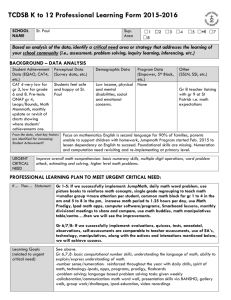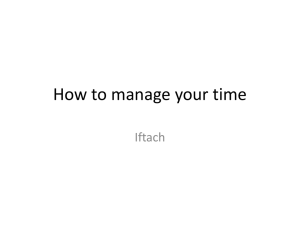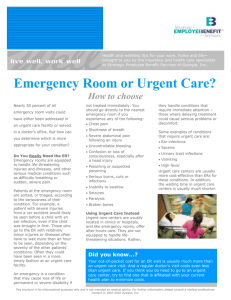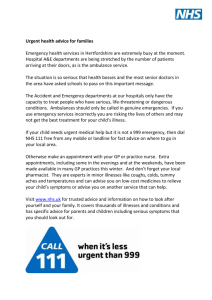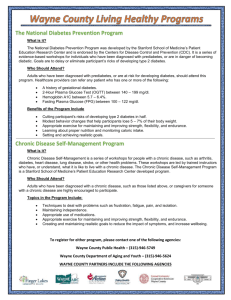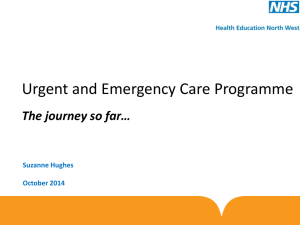1 - Doutta Galla Community Health
advertisement
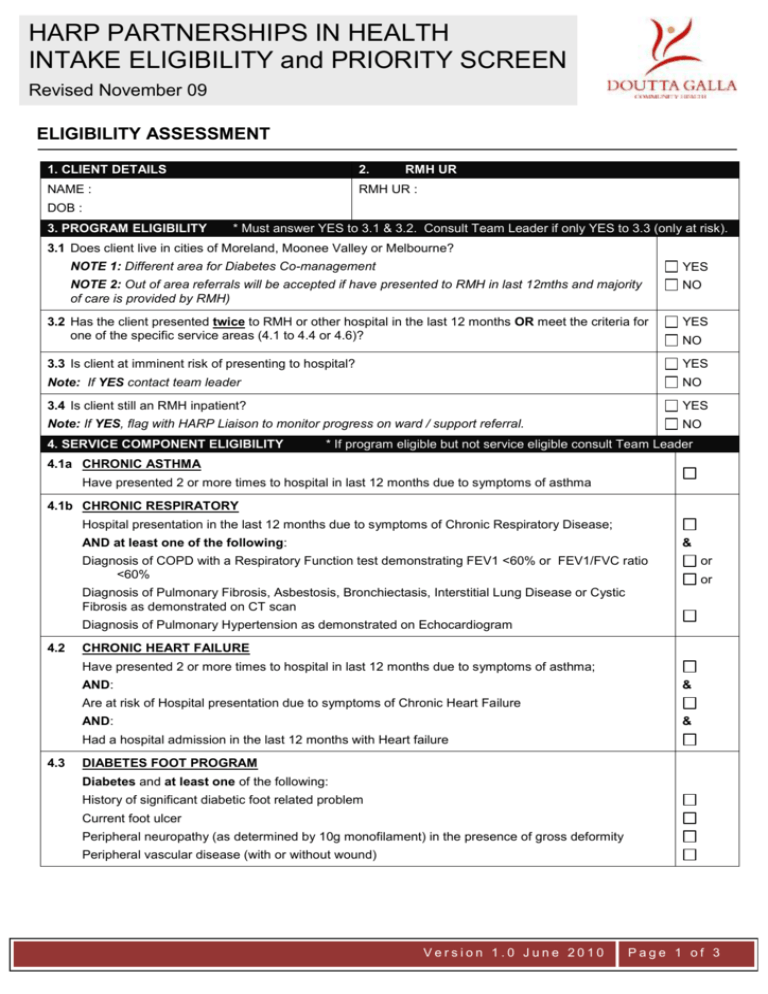
HARP PARTNERSHIPS IN HEALTH INTAKE ELIGIBILITY and PRIORITY SCREEN Revised November 09 ELIGIBILITY ASSESSMENT 1. CLIENT DETAILS 2. RMH UR NAME : RMH UR : DOB : 3. PROGRAM ELIGIBILITY * Must answer YES to 3.1 & 3.2. Consult Team Leader if only YES to 3.3 (only at risk). 3.1 Does client live in cities of Moreland, Moonee Valley or Melbourne? NOTE 1: Different area for Diabetes Co-management YES NOTE 2: Out of area referrals will be accepted if have presented to RMH in last 12mths and majority of care is provided by RMH) NO 3.2 Has the client presented twice to RMH or other hospital in the last 12 months OR meet the criteria for one of the specific service areas (4.1 to 4.4 or 4.6)? NO 3.3 Is client at imminent risk of presenting to hospital? YES Note: If YES contact team leader NO 3.4 Is client still an RMH inpatient? YES Note: If YES, flag with HARP Liaison to monitor progress on ward / support referral. NO 4. SERVICE COMPONENT ELIGIBILITY YES * If program eligible but not service eligible consult Team Leader 4.1a CHRONIC ASTHMA Have presented 2 or more times to hospital in last 12 months due to symptoms of asthma 4.1b CHRONIC RESPIRATORY Hospital presentation in the last 12 months due to symptoms of Chronic Respiratory Disease; AND at least one of the following: & Diagnosis of COPD with a Respiratory Function test demonstrating FEV1 <60% or FEV1/FVC ratio <60% or or Diagnosis of Pulmonary Fibrosis, Asbestosis, Bronchiectasis, Interstitial Lung Disease or Cystic Fibrosis as demonstrated on CT scan Diagnosis of Pulmonary Hypertension as demonstrated on Echocardiogram 4.2 CHRONIC HEART FAILURE Have presented 2 or more times to hospital in last 12 months due to symptoms of asthma; AND: & Are at risk of Hospital presentation due to symptoms of Chronic Heart Failure AND: & Had a hospital admission in the last 12 months with Heart failure 4.3 DIABETES FOOT PROGRAM Diabetes and at least one of the following: History of significant diabetic foot related problem Current foot ulcer Peripheral neuropathy (as determined by 10g monofilament) in the presence of gross deformity Peripheral vascular disease (with or without wound) Version 1.0 June 2010 Page 1 of 3 4. SERVICE COMPONENT ELIGIBILITY (Continued) 4.4 DIABETES CO-MANAGEMENT Diagnosis of Type 1 or Type 2 Diabetes AND one or more of the following: & Diagnosis of diabetes for ≥15years &/or HbA1c≥9% (test in last 6 months) &/or 2+ high risk foot factors, &/or Microalbuminuria confirmed diagnosis &/or History of cardiovascular disease &/or Diabetes related hospital presentation/admission in last 12 mths &/or Proliferative retinopathy &/or NOTE: Must live in geographical area above or be patient of one of participating GPs (see GP list) 4.5 CARE FACILITATION Have had 2 or more presentations to hospital in the past 12 months AND & Have complex issues and / or difficulty engaging with mainstream services AND & Require comprehensive assessment and intensive care coordination to address issues effecting representation to hospital. For example referrals to other services, liaison with existing service providers, advocacy and support VINAH Program type (internal use only) Hospitalisations or presentations to ED are primarily for complex psychosocial reasons such as homelessness, substance abuse, mental health, social isolation = ISC-P – Psychosocial program. NOTE: If referral information indicates mental health issues, contact HARP Liaison to check eligibility so can check if Mental Health already involved Other complex issues = ISC – Complex Needs Program 4.6. FALLS PREVENTION Have had 1 or more falls related hospitalisation or presentation to an emergency department in the past 12 months REJECTED, or ACCEPTED, allocated to: PRIORITY SCREEN 1. GENERAL RISK SCREENING TO BE ASCERTAINED FROM REFERRER FOR ALL REFERRALS; These questions are designed to elicit information to answer Q3. The more “YES” the greater the urgency A. Does the client live alone? YES NO B. Is the client likely to have self care problems? YES NO C. Does the client care for someone else? YES NO D. Is the client already using community services? YES NO E. Does the client have difficulty walking? YES NO F. Does the client have cognitive impairment? YES NO G. Is the client at risk of self harm? YES NO H. Is the client medically unstable? YES NO I. Has client been discharged in the last week? YES NO Version 1.0 June 2010 Page 2 of 3 2. SPECIFIC URGENCY CRITERIA FOR HEARTWISE CLIENTS A. Is the client currently experiencing worsening shortness of breath? YES NO B. Has the client recently been commenced on a Beta Blocker, ACE Inhibitor or Diuretic Therapy? YES NO C. Does the client have worsening peripheral oedema? YES NO D. Does the client have adequate access to their GP? YES NO Does the client have newly prescribed oxygen therapy? YES NO E. 2.1. SPECIFIC URGENCY CRITERIA FOR MELBOURNE EASY BREATHERS CLIENTS Priority 1: Urgent A. Does the client have acute worsening Shortness of Breath? YES B. Requires immediate home intervention to prevent a Respiratory hospital admission YES Priority 2: Semi Urgent C. Does the client have newly prescribed home oxygen therapy YES D. Does the client require Airway Clearance YES Priority 3: Not Urgent E. Does the client require Pulmonary Rehabilitation only YES F. Does the client require Home Exercise and Education program only YES NOTE: Melbourne Easy Breathers do not require further Priority Screening (below). 3. PRIORITY PRIORITY 1: URGENT PRIORITY 2: SEMI URGENT Client is not at immediate risk of harm Client has some supports There is progressive deterioration in the client’s physical, mental or functional status High risk of presentation to hospital due to sudden exacerbation of medical condition and/or sudden decline in functional status / mental status Sudden Carer Withdrawal Client is a carer and has significant carer responsibilities High Client Safety risk due to conflict or relationship crisis or threat of self harm or significant hazards in the home There is progressive deterioration in the carer’s physical, mental or functional status High risk of homelessness There is need for self management education and or early intervention PRIORITY 3: NOT URGENT The referral indicates the client has sufficient support available at present PRIORITY 1: URGENT Phone area to enable key worker to respond within 24 hours Client requires assessment regarding future care requirements client’s health or social issues PRIORITY 2: SEMI URGENT Response required within 3 working days P2 Some complexity around medical and/ or social factors however a client is able to comply with recommendations PRIORITY 3: NOT URGENT – Response required within 5 working days P3 P1 COMMENTS: Version 1.0 June 2010 Page 3 of 3
